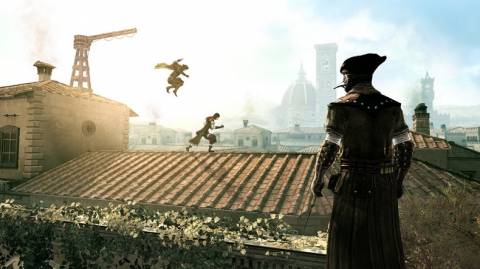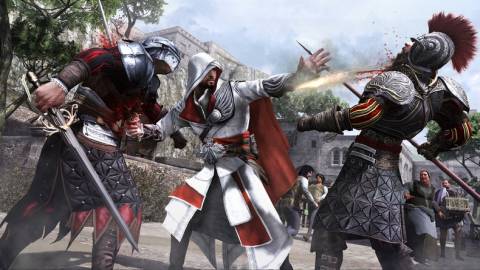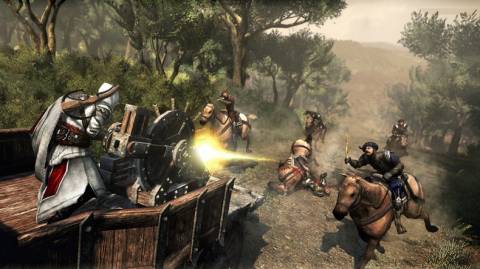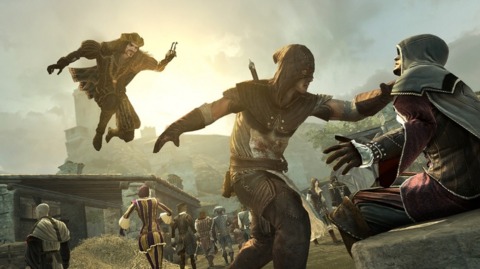
If you finished Assassin’s Creed II, you no doubt have some burning questions about just what in the holy hot hell is going on in this universe, which has pretty rapidly escalated its already tripped-out, high-concept premise of ancient, clandestine groups of Templars and assassins using genetic memories to hunt down powerful artifacts of mysterious, even more ancient origin. Picking up right where ACII left off, Brotherhood sees Ezio doing a victory lap of sorts after recovering the Pieces of Eden and learning a bit about their true nature. While he finds some time for the ladies, it’s not long before a new Templar threat, in the form of the categorically creepy Borgia family, is literally knocking on his door, stealing the Apple of Eden, destroying his country villa, and further shattering the remains of the Auditore family, all in dramatic fashion. With the Apple in their possession, and the backing of the Pope himself, the Borgia have absolute power over Rome, and Ezio spends the grand majority of the game systematically sabotaging their power structure while also gaining the support of the people of Rome for his own chapter of the assassin’s guild.
Several key supporting characters from Assassin’s Creed II return here, including Ezio’s sister Claudia and his love interest Caterina Sforza, as well as the historically unfettered caricatures of Niccolo Machiavelli and Leonardo da Vinci, all of whom are given room to develop. Though you’ll spend more meaningful time here playing as Desmond than in the first two games combined, his story mostly bookends the main narrative, exploring his burgeoning relationship with his ragtag team of modern assassins and hinting further at just what in the holy hot hell is going on in this universe. Frankly, I found myself so engrossed in the nuts and bolts of the world itself that a lot of the specific story beats were kind of a blur--I was less interested in the specific whos and the whys of my murderous pursuits than I was the actual execution. In a way, the predestined nature of Ezio’s story makes it not really matter in the grand scheme, though the final moments with Desmond left me feeling baffled by the mop of loose ends it rather deliberately leaves cliff-hung.

A lot of the activities introduced in Assassin’s Creed II are expanded on, or at the very least, multiplied. The real-estate angle from ACII has been opened up to let you purchase dozens of blacksmiths, art dealers, banks, and clothing stores, all the way up to actual Roman landmarks like the Pantheon and the Colosseum, with each purchase increasing your periodic income. Before you can start getting your Monopoly on, you need to rid the area of the Borgias' corrupting influence by destroying their tower in the district, a task which adds a little assassination mission to the tower-climbing business that has been an Assassin’s Creed staple. Unlike Assassin’s Creed II, you can now replay any story mission out of order, and each mission now has a secondary win condition, such as never breaking stealth or executing enemies in a specific fashion. There are side missions and challenges to be taken from thieves, mercenaries, and courtesans, a fun series of missions tasking you with stealing, using, and destroying some fantastical da Vinci-built war machines that the Borgia have in their possession, pickpockets and Borgia agents to chase around the city, shop-specific collection goals, and just a load of posters, feathers, flags, and treasure chests to be collected. At a certain point, the world of Brotherhood opens up, and it kind of never stops blossoming, and it constantly introduces something new to do. When you pull up the map to try and decide what you’re going to do next, it can be downright overwhelming. This is not a short game, and while I didn’t stick to the critical path, I probably spent a good 20 hours with Assassin’s Creed: Brotherhood, and the mad completionists out there will surely put that number to shame.

The biggest gamble in Assassin’s Creed: Brotherhood is the new multiplayer mode, which goes to some pretty clever lengths to adopt something recognizable as the Assassin’s Creed gameplay into a player-versus-player experience. The premise here is that all of the players are Abstergo trainees being taught in the ways of the assassins with networked Animus scenarios designed to help them better understand their enemy. This makes room for the biggest contrivance in the multiplayer, albeit a necessary one. Games can support up to eight players, and as such, there are eight different player models to choose from, and only one player can use one of those models in any given game. The levels are then populated exclusively with benign AI versions of the models, providing you with crowds of pedestrians to blend in with. There are a few different free-for-all and team-based configurations, but the basic idea is that everyone is given a specific player to assassinate, making everyone both hunter and hunted, creating this cat-and-mouse Mobius strip of sorts. In addition to your target’s face, you’re also provided with a simple directional compass that provides a general idea of where and how far away they are, though at a certain point you have to use your skills of observation to figure out who’s a real person and who’s AI.

Brotherhood lacks that generational leap we saw from Assassin’s Creed to Assassin’s Creed II, but it more than makes up for that with a full-bodied single-player experience teeming with interesting gameplay additions and a risky multiplayer component. Even more surprising than the single-player experience is the addition of a competitive multiplayer game that, through some downright acrobatic contrivances, manages to make the cat-and-mouse core of the single-player work with live opponents. For fans of the series Brotherhood is no optional sidebar; this is as significant an entry as either of its predecessors. It’s also about as fun as Assassin’s Creed has ever been.